| |
AIA Convention Offers Tribute to Piano, McKittrick, Tigerman
Summary: Participants at the AIA national convention plenary session on Friday, May 16, paid tribute to 2008 AIA Gold Medal recipient Renzo Piano, Hon. FAIA; Kemper Award recipient Thomas L. McKittrick, FAIA; and Topaz Medallion recipient Stanley Tigerman, FAIA. The group also listened to a report on the legacy activities marking the AIA’s 150th anniversary celebration by AIA Executive Vice President/CEO Christine McEntee and an update on the American Architectural Foundation from Jess Wendover, Assoc. AIA.
 AIA Executive Vice President/CEO Christine McEntee opened the second morning’s session recognizing Robert Traynham Coles, FAIA. This accomplished AIA member earned his MArch from MIT in 1955 and established what is now the oldest African-American-owned architecture firm in New York State and the Northeast back in 1963. He received the Whitney M. Young Jr. Citation in 1981 for his contributions to the cause of social justice and, in 1995, served as chancellor of the AIA College of Fellows. “All this would be excuse enough to shine a spotlight on him. What you may not know is that Robert Traynham Coles, FAIA, has attended AIA conventions every year for 40 years,” noted McEntee, as she welcomed the audience to the plenary session. “I think that deserves a big round of applause!” AIA Executive Vice President/CEO Christine McEntee opened the second morning’s session recognizing Robert Traynham Coles, FAIA. This accomplished AIA member earned his MArch from MIT in 1955 and established what is now the oldest African-American-owned architecture firm in New York State and the Northeast back in 1963. He received the Whitney M. Young Jr. Citation in 1981 for his contributions to the cause of social justice and, in 1995, served as chancellor of the AIA College of Fellows. “All this would be excuse enough to shine a spotlight on him. What you may not know is that Robert Traynham Coles, FAIA, has attended AIA conventions every year for 40 years,” noted McEntee, as she welcomed the audience to the plenary session. “I think that deserves a big round of applause!”
The audience responded most enthusiastically.
Tribute to AIA 150
This session also paid tribute to the efforts that brought forth last year’s celebration of the Institute’s 150th anniversary and continue to this day. Specifically, McEntee named:
- The “America’s Favorite Architecture” poll and resulting Web site, so popular it shut down the AIA’s servers for several hours when it first opened. It lives to this day on the Web and in a traveling exhibition developed from the poll. The site won a “People’s Voice Webby Award” earlier in May.
- The “Shape of America” initiative, launched earlier this year, a Web-based series that features panel discussions by AIA members talking about projects that make up the fabric of communities across the nation—and inviting viewers to share their own recollections and opinions.
- The “Blueprint for America” initiative, which provided grants to 156 of our components, allowing the public to collaborate with AIA architects to share their ideas for creating livable communities. These projects are being gathered into a “Blueprint for America Mosaic.”
- A Legacy of Leadership, by former AIA President R. Randall Vosbeck, FAIA, which offers a chronological journey of the AIA’s presidents and their contribution to the AIA and the profession they served, being released at the convention.
- Architecture: Celebrating the Past, Designing the Future, which offers an inspirational tour of a century and a half of American architecture.
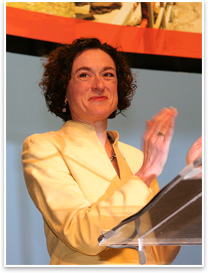 In closing, McEntee thanked everyone who contributed to the AIA150 underwriting campaign, in particular the two Founders Circle partners, McGraw-Hill Construction (the official AIA150 Media Sponsor) and Autodesk (the official AIA150 Software Sponsor). In closing, McEntee thanked everyone who contributed to the AIA150 underwriting campaign, in particular the two Founders Circle partners, McGraw-Hill Construction (the official AIA150 Media Sponsor) and Autodesk (the official AIA150 Software Sponsor).
Honoring AIA Gold Medalist Renzo Piano
“Last December, President Purnell and I had the great privilege of participating in a ceremony at the National Building Museum. The occasion was the awarding of the AIA Gold Medal to Renzo Piano,” McEntee said. “A prior commitment prevented Mr. Piano from attending this convention. However, I want to share some of the magic of that night and the man himself.” The audience then viewed a short excerpt from a videotaped interview of Renzo Piano, Hon. FAIA, with AIA Managing Director of Communications and Marketing Phil Simon.
In the video, Piano expressed regret that he had never taught at the university level, yet expressed his commitment to teaching through his office. People entering the profession will do what they are told, he said, but more, they have to understand what they are doing. They are curious and they want to steal this information, so he encourages it. Curiosity isn’t rebellion, he said, “but, then, rebellion is not such a bad thing.”
Following the video, Purnell recognized the Shadow an Architect program participants, asking them to rise for the audience’s applause and appreciation. “The politics of hope” is how he described the program, which involves secondary school students from across the city coming to tour the convention for a day under the direction of a volunteer AIA member.
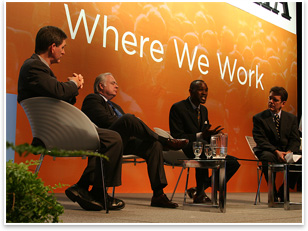 The balance of freedom and security The balance of freedom and security
Yesterday’s keynote address was to “feed the heart,” Purnell noted, while the Friday session was to “feed the mind.” The city is a golden door of opportunity for people of all walks of life around the world. Yet, when the balance of freedom and security are not addressed, situations such as those in New Orleans and Baghdad are the result, he said as he introduced the panelists for the day’s keynote panel, moderated by urban security expert Thomas Vonier, FAIA, and bringing together Ambassador Henry A. Crumpton, who leveled his insight on the shifts in global threats; Derreck Kayongo, originally from Uganda, who spoke eloquently to the needs of 3 billion people worldwide living on less than $2 a day; and the Honorable Douglas P. Woodlock, a judge presiding in Boston, who focused his wit and wisdom on contemporary domestic threats both from terrorists and those who would overreact to them to the detriment of city planning. (Read a full report on the Urban Security in the 21st Century theme session.)
A word from the Foundation
Senior Director for Programs at the American Architectural Foundation and Director of the Mayor’s Institute on City Design Jess Wendover, Assoc.AIA, provided an update of the AAF’s ongoing programs, notably:
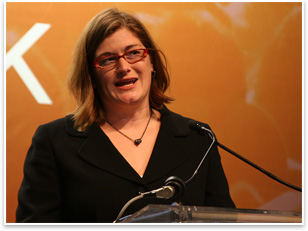 The Redesign Your School Contest for High School Students, co-sponsored by Target. This year, the AAF will publish the accumulated design thinking from the hundreds of talented high school students who submitted entries to the competition. Look for this guide in the fall as a resource to designers who are curious about what our nation's youth think about design. The Redesign Your School Contest for High School Students, co-sponsored by Target. This year, the AAF will publish the accumulated design thinking from the hundreds of talented high school students who submitted entries to the competition. Look for this guide in the fall as a resource to designers who are curious about what our nation's youth think about design.- In addition to multi-year support from Bank of America, this year the Mayors' Institute has received a generous grant from the Rose Family Foundation, through a gift directed to the National Endowment for the Arts. With this new support, the Mayors' Institute will begin to offer assistance to mayors who have already attended a regular Mayors' Institute session and would like an opportunity to bring further design advice back into their communities. An example is Virginia Bass, mayor of Eureka, Calif., who said the institute “has made me a zealot,” Wendover reported.
- This year, the Foundation announced that the AIA will join AAF and the Chicago Architecture Foundation to run the Architectural and Design Education Network, (A+DEN). “On behalf of our partners at the AIA and the Chicago Architecture Foundation, I want to invite you to join us at the A+DEN international conference for design educators scheduled for June 20-21 in Chicago,” Wendover said. “We are deeply grateful to the AIA as a partner, supporter, and colleague in the effort to engage and educate community leaders about the power of architecture to change lives and transform communities.”
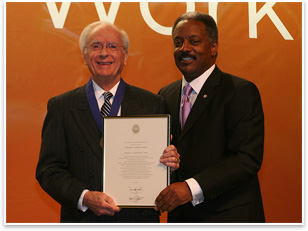 McKittrick receives Kemper McKittrick receives Kemper
Purnell bestowed the Kemper award on professor emeritus of Texas A&M, Thomas L. McKittrick, FAIA. Named after the Institute’s first executive director, who devoted nearly 35 years of his life to creating a modern professional society, the Kemper Award is an honor conferred each year by the AIA Board. The recipient is an architect member who, in the spirit of Kemper, has contributed significantly to the profession through service to the Institute. In more than 40 years dedicated to the AIA, McKittrick has served as president of the Houston Chapter/AIA, president of the Texas Society of Architects, and a member of the national Board as well as a national vice president.
 “I am the luckiest architect in the world,” McKittrick said, noting the presence in the audience of his wife and daughters. From childhood he planned to be an architect he said, but it was at Rice University that he came to believe that “real architects belong to the AIA.” “I am the luckiest architect in the world,” McKittrick said, noting the presence in the audience of his wife and daughters. From childhood he planned to be an architect he said, but it was at Rice University that he came to believe that “real architects belong to the AIA.”
“In 28 years of practice, and 14 years of teaching, it has been my good fortune to work with countless dedicated architect and educator friends,” McKittrick said, thanking his nominators, the Board, and those who wrote letters of support. “In homage to my architect friends abroad and to this convention’s sub-theme, ‘Our Place in the World,’ I’ve borrowed lyrics from ‘Finlandia,’ arranged by composer Jean Sibelius:
My country's skies are bluer than the ocean,
And sunlight beams on cloverleaf and pine.
But other lands have sunlight too and clover,
And skies are everywhere as blue as mine.
Oh hear my song, oh God of all the nations,
A song of peace for their land and for mine.
“I am deeply moved by this award. Thank you,” McKittrick concluded.
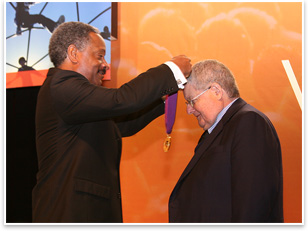 Topas Medallion presented to Tigerman Topas Medallion presented to Tigerman
The Topaz Medallion, jointly awarded by the AIA and the Association of Collegiate Schools of Architecture, recognizes an individual who has made outstanding contributions to architecture education for at least 10 years. Last March in Houston, AIA First Vice President Marvin Malecha, FAIA, joined ACSA President Kim Tanzer to bestow the Topaz Medallion on Stanley Tigerman, FAIA.
“I’m not an educator teaching the field of architecture,” Tigerman said in a short film clip Purnell introduced. “I’m an architect teaching architecture. And architecture is intrinsically ethical, and if it isn’t, who wants it, who needs it . . . Architecture is not for cowards.”
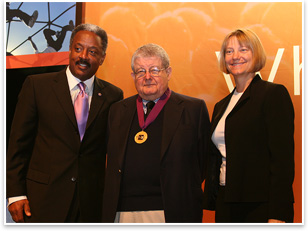 Tanzer took the convention stage to honor the man who established his own practice in 1962, which he continues today with his wife, Margaret McCurry, FAIA. Blending practice with education, he began his career in architecture education in 1963 as a visiting critic at Cornell University’s architecture school. In 1964, he served as a visiting critic at Washington University and secured an appointment to the permanent faculty at the University of Illinois, Chicago. In 1985, he was appointed director of UIC’s architecture school, which he directed and for which he taught full-time until 1993. Tanzer took the convention stage to honor the man who established his own practice in 1962, which he continues today with his wife, Margaret McCurry, FAIA. Blending practice with education, he began his career in architecture education in 1963 as a visiting critic at Cornell University’s architecture school. In 1964, he served as a visiting critic at Washington University and secured an appointment to the permanent faculty at the University of Illinois, Chicago. In 1985, he was appointed director of UIC’s architecture school, which he directed and for which he taught full-time until 1993.
In 1994, together with Eva Maddox, he co-founded ARCHEWORKS, a one-year post-professional design school grounded in social causes, which continues today. He has been a visiting chaired professor at numerous universities, including Yale and Harvard, and served on advisory committees at Yale and Princeton, the Chicago Art Institute, and Chicago Latin School’s “High Jump” program.
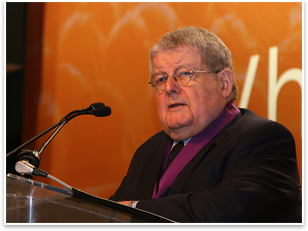 “Thanks very much,” Tigerman said after receiving the award from Purnell. “Boston is a suitable place for me to be awarded the Topaz Medallion, since six decades earlier, I flunked out of MIT. I want to thank Jane Weinzapfel and the Boston Society of Architects for nominating me; the ACSA/AIA jury, chaired by John Jeronimo, for selecting me; Paul Rudolph, for fabricating me out of whole cloth; John Hajdek, for inspiring me to appreciate the poetic aspects of our discipline; Muzharul Islam, the father of architecture in Bangladesh, for enlightening me as to the importance of morality and ethics; all of the deans who hired me, except the last dean who fired me; Eva Maddox who fought to find common ground so as to bring our works into being; Doug Garofalo and Bob Somol for challenging me; and, last but not least, to Margaret McCurry for tolerating me.” “Thanks very much,” Tigerman said after receiving the award from Purnell. “Boston is a suitable place for me to be awarded the Topaz Medallion, since six decades earlier, I flunked out of MIT. I want to thank Jane Weinzapfel and the Boston Society of Architects for nominating me; the ACSA/AIA jury, chaired by John Jeronimo, for selecting me; Paul Rudolph, for fabricating me out of whole cloth; John Hajdek, for inspiring me to appreciate the poetic aspects of our discipline; Muzharul Islam, the father of architecture in Bangladesh, for enlightening me as to the importance of morality and ethics; all of the deans who hired me, except the last dean who fired me; Eva Maddox who fought to find common ground so as to bring our works into being; Doug Garofalo and Bob Somol for challenging me; and, last but not least, to Margaret McCurry for tolerating me.”
|
|


 AIA Executive Vice President/CEO Christine McEntee opened the second morning’s session recognizing Robert Traynham Coles, FAIA. This accomplished AIA member earned his MArch from MIT in 1955 and established what is now the oldest African-American-owned architecture firm in New York State and the Northeast back in 1963. He received the Whitney M. Young Jr. Citation in 1981 for his contributions to the cause of social justice and, in 1995, served as chancellor of the AIA College of Fellows. “All this would be excuse enough to shine a spotlight on him. What you may not know is that Robert Traynham Coles, FAIA, has attended AIA conventions every year for 40 years,” noted McEntee, as she welcomed the audience to the plenary session. “I think that deserves a big round of applause!”
AIA Executive Vice President/CEO Christine McEntee opened the second morning’s session recognizing Robert Traynham Coles, FAIA. This accomplished AIA member earned his MArch from MIT in 1955 and established what is now the oldest African-American-owned architecture firm in New York State and the Northeast back in 1963. He received the Whitney M. Young Jr. Citation in 1981 for his contributions to the cause of social justice and, in 1995, served as chancellor of the AIA College of Fellows. “All this would be excuse enough to shine a spotlight on him. What you may not know is that Robert Traynham Coles, FAIA, has attended AIA conventions every year for 40 years,” noted McEntee, as she welcomed the audience to the plenary session. “I think that deserves a big round of applause!” In closing, McEntee thanked everyone who contributed to the AIA150 underwriting campaign, in particular the two Founders Circle partners, McGraw-Hill Construction (the official AIA150 Media Sponsor) and Autodesk (the official AIA150 Software Sponsor).
In closing, McEntee thanked everyone who contributed to the AIA150 underwriting campaign, in particular the two Founders Circle partners, McGraw-Hill Construction (the official AIA150 Media Sponsor) and Autodesk (the official AIA150 Software Sponsor). The balance of freedom and security
The balance of freedom and security The Redesign Your School Contest for High School Students, co-sponsored by Target. This year, the AAF will publish the accumulated design thinking from the hundreds of talented high school students who submitted entries to the competition. Look for this guide in the fall as a resource to designers who are curious about what our nation's youth think about design.
The Redesign Your School Contest for High School Students, co-sponsored by Target. This year, the AAF will publish the accumulated design thinking from the hundreds of talented high school students who submitted entries to the competition. Look for this guide in the fall as a resource to designers who are curious about what our nation's youth think about design. McKittrick receives Kemper
McKittrick receives Kemper “I am the luckiest architect in the world,” McKittrick said, noting the presence in the audience of his wife and daughters. From childhood he planned to be an architect he said, but it was at Rice University that he came to believe that “real architects belong to the AIA.”
“I am the luckiest architect in the world,” McKittrick said, noting the presence in the audience of his wife and daughters. From childhood he planned to be an architect he said, but it was at Rice University that he came to believe that “real architects belong to the AIA.” Topas Medallion presented to Tigerman
Topas Medallion presented to Tigerman Tanzer took the convention stage to honor the man who established his own practice in 1962, which he continues today with his wife, Margaret McCurry, FAIA. Blending practice with education, he began his career in architecture education in 1963 as a visiting critic at Cornell University’s architecture school. In 1964, he served as a visiting critic at Washington University and secured an appointment to the permanent faculty at the University of Illinois, Chicago. In 1985, he was appointed director of UIC’s architecture school, which he directed and for which he taught full-time until 1993.
Tanzer took the convention stage to honor the man who established his own practice in 1962, which he continues today with his wife, Margaret McCurry, FAIA. Blending practice with education, he began his career in architecture education in 1963 as a visiting critic at Cornell University’s architecture school. In 1964, he served as a visiting critic at Washington University and secured an appointment to the permanent faculty at the University of Illinois, Chicago. In 1985, he was appointed director of UIC’s architecture school, which he directed and for which he taught full-time until 1993. “Thanks very much,” Tigerman said after receiving the award from Purnell. “Boston is a suitable place for me to be awarded the Topaz Medallion, since six decades earlier, I flunked out of MIT. I want to thank Jane Weinzapfel and the Boston Society of Architects for nominating me; the ACSA/AIA jury, chaired by John Jeronimo, for selecting me; Paul Rudolph, for fabricating me out of whole cloth; John Hajdek, for inspiring me to appreciate the poetic aspects of our discipline; Muzharul Islam, the father of architecture in Bangladesh, for enlightening me as to the importance of morality and ethics; all of the deans who hired me, except the last dean who fired me; Eva Maddox who fought to find common ground so as to bring our works into being; Doug Garofalo and Bob Somol for challenging me; and, last but not least, to Margaret McCurry for tolerating me.”
“Thanks very much,” Tigerman said after receiving the award from Purnell. “Boston is a suitable place for me to be awarded the Topaz Medallion, since six decades earlier, I flunked out of MIT. I want to thank Jane Weinzapfel and the Boston Society of Architects for nominating me; the ACSA/AIA jury, chaired by John Jeronimo, for selecting me; Paul Rudolph, for fabricating me out of whole cloth; John Hajdek, for inspiring me to appreciate the poetic aspects of our discipline; Muzharul Islam, the father of architecture in Bangladesh, for enlightening me as to the importance of morality and ethics; all of the deans who hired me, except the last dean who fired me; Eva Maddox who fought to find common ground so as to bring our works into being; Doug Garofalo and Bob Somol for challenging me; and, last but not least, to Margaret McCurry for tolerating me.”